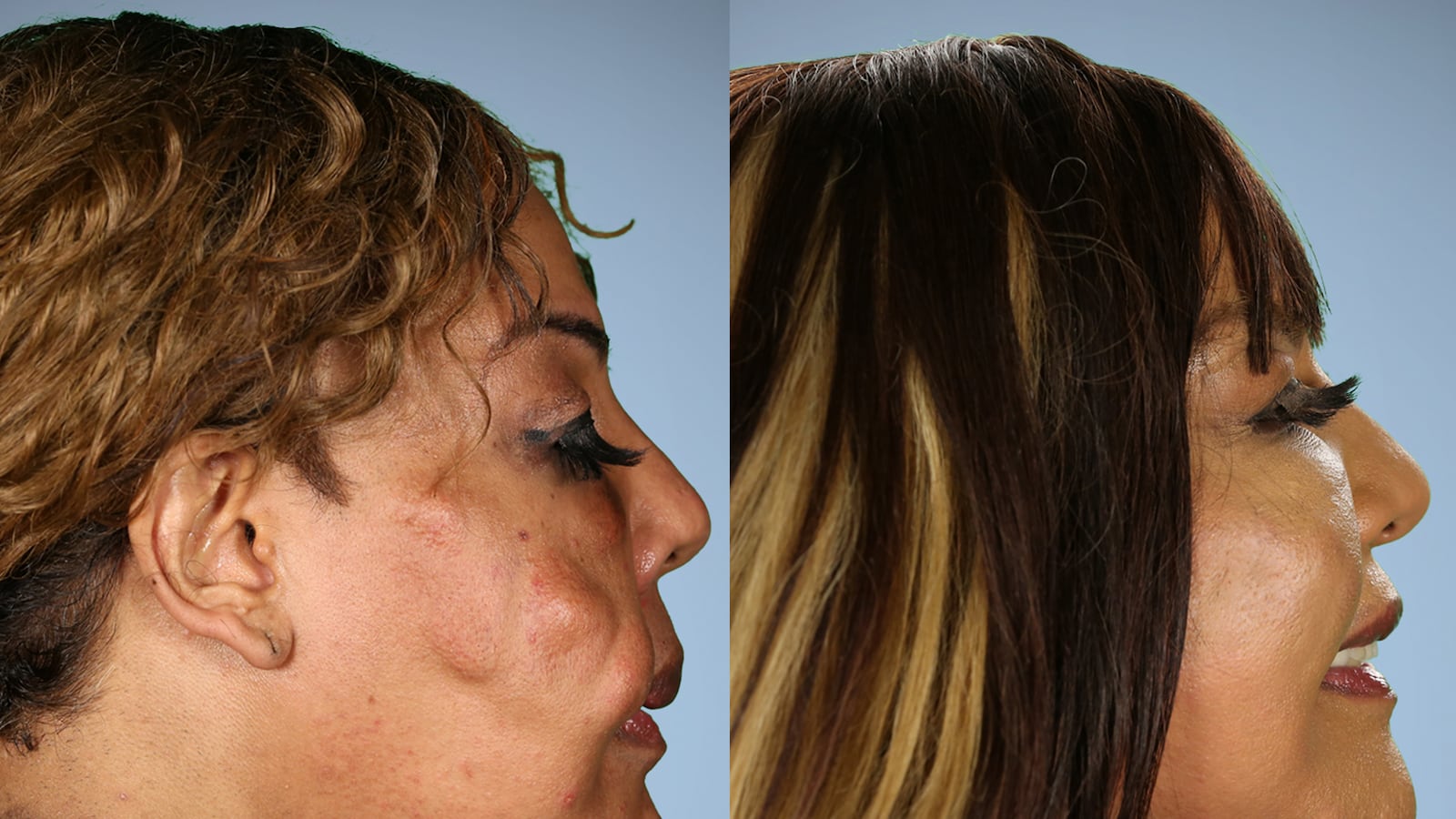Perfection has never been more en vogue. By extension, neither has plastic surgery.
No one is more aware of that state of society than Dr. Terry Dubrow and Dr. Paul Nassif, two of Los Angeles’s most in-demand surgeons and, thanks to the success of their E! reality series Botched, two of reality TV’s biggest stars.
That also makes them two of the most interesting, if not conflicted, kinds of TV personalities. They are two doctors who have created a television show warning against the dangers of plastic surgery and the often harmful—and certainly unattainable—pursuit of perfection, but are professionals and public figures who are benefitting both financially and socially from that very thing.
That nuance, though, is exactly the appeal of Botched. Our national obsession with plastic surgery—gawking at it, gossiping over who has done it, and, well, having it—has yielded, expectedly, many attempts over the years to capitalize on the fascination via reality TV.
There was The Swan, which literally used plastic surgery to turn ugly ducklings (actual women) into beautiful swans to compete in a televised beauty pageant, and Bridalplasty, in which 12 engaged brides competed to win a wedding—and transformative plastic surgery procedure to make the betrothed as bangable as possible for the big day.
But Botched, which launched its third season on Tuesday, has proved more popular than, and outlasted, both of them.

Dr. Dubrow, who in fact performed surgeries on both of those previous reality series, has a theory for why. “The difference between this show and other plastic surgery shows is that we’re not glamorizing plastic surgery,” he says. “In fact, we’re providing a scare about plastic surgery.”
As a culture, as much as we fetishize perfection to the point of insisting on plastic surgery as the only recourse to achieve it, we also tend to gawk it at it, if not even judge people who have it. It’s what made those previous reality series seem exploitative, and even inhuman.
“Unfortunately, people like to watch train wrecks,” Dr. Nassif says. “But if you can take a train wreck and then add the inspirational aspect of having a good result or a happy ending, I think that fills a void [in reality TV].”
The premise of Botched is two-fold. Part of it gives into our perverse desire to ogle the trainwrecks and turn the plastic surgeried into veritable zoo exhibits. That Justin Jedlica, “The Human Ken Doll” with the goal of becoming “100 percent plastic,” has become somewhat of a recurring character on the show speaks to that.
But the other part appeases our craving to be uplifted: Most patients, and certainly the most memorable ones, go to Dr. Nassif and Dr. Dubrow as a last resort.
Their pursuit of perfection through plastic surgery has left them with deformities, some that are often even life-threatening, that have crippled their lives and their spirits. Because their expertise lies in revisional plastic surgery—and because they are among the best in the industry at that—the Botched docs don’t just make these creature-features human again. They give them their lives back.
It’s Extreme Home Makeover. But with faces and bodies.
Both doctors (and not just because it happens to be the season they’re promoting) point to a patient from Tuesday’s Season 3 premiere as the best, most emotional example of Botched’s purest mission.
The episode featured the return of a patient named Rajee Narinesingh, a transgender woman who injected her lips and cheeks with a filler she bought off the black market in order to appear more feminine. The injections ended up being cement-like, and her face completely deformed to the point of, at one time, inoperability.
The doctors had actually turned her away in an earlier season as one of their many cautionary tales. “There are a lot of cases on the show where we bring in people and say, ‘That’s not fixable, but let’s air their stories as a cautionary tale.’” With Narinesingh, it was too risky on the face’s nerve and blood vessels to operate.
But three seasons later, and three years more of expertise and medical advances, they were able to formulate a plan, execute it, and finally change her life.
That kind of uplifting, high-stakes journey—the very dangerous surgery makes for incredibly tense TV—pairs well with the show’s signature levity. The premiere, for example, also features a patient who would like to resemble a Martian, and Dr. Dubrow and Dr. Nassif’s self-proclaimed bromance.
(“You know what, I just had the greatest idea,” Dr. Dubrow says midway through our interview after being interrupted by Dr. Nassif. “You know how on Game of Thrones and The Walking Dead they kill off some subpar character? It’s a great idea to kill your character off of Botched. Just right in the middles of the season. You pass gas in the surgery and there’s a big O.R. fire and you just blow up.” Dr. Nassif responds by laughing hysterically.)
It all combines into a reality TV formula that really, truly works—to the point that the doctors now have a spinoff, Botched By Nature, in the works. But three-and-a-half years ago, when Dr. Nassif approached Dr. Dubrow with the idea for the show, his now bromance partner thought it was a terrible idea.
“As a plastic surgeon, you’re not judged by the before vs. after,” Dr. Dubrow says. “You’re judged just by the after.” That person, in other words, is not going to walk around with a photo of how bad their flubbed surgery made them look before they appeared on Botched for comparison’s sake.
But not only that, these are highly risky cases. Many of the patients have been seen by 10 doctors before showing up at Dr. Nassif and Dr. Dubrow’s office. If they couldn’t be fixed before, why would they be the ones with the magic touch?
“At the end of the day it is serious and scary,” Dr. Dubrow says. “It could go very wrong. This season, some of the cases go wrong on us, and we show that. Warts and all.”
But it’s not just the heartwarming angle to plastic surgery that Botched so cleverly, and almost unfathomably, hit on—nor the cautionary tale making very real the risk and the danger of having these cosmetic procedures, no matter how routine, done. The series is also striking as our culture’s relationship to and candidness about the procedures is evolving, too.
It’s a hilarious cultural hypocrisy: bow down to the sexiness of a magazine cover or celebrity’s photo, but then be disgusted when you discover that Photoshop or surgery were involved in looking that flawless. In today’s day and age, truly it’s only Beyoncé who #wokeuplikedis.
But that doesn’t mean that what’s “allowed,” as far as plastic surgery goes, hasn’t changed.
In the ’80s, the Botched doctors say, no one—celebrities, ladies who lunch, what have you—could cop to any work done. Then the ’90s forgave and even couraged a little Botox, and then it was OK to admit to fillers. But not breast augmentations! Then things evolved. More celebrities began to even brag about their implants.

Liposuction, however, was still taboo to talk about. “Because it implied that you were lazy or fundamentally fat,” Dr. Dubrow says. Eventually, though, that, too, became OK, coupling with it becoming on trend to admit that it’s impossible to achieve the old Holy Grail of “having it all.” If a little nip and tuck was needed to preserve appearance while killing it in all other realms, it became relatable, even, to confess that.
“Right now you can admit to almost anything,” Dr. Dubrow says. After all, every stage of our lives is carefully documented. If you changed your appearance, there’s an old Facebook photo somewhere as proof.
There is one caveat: “No one will admit to having their butt done.” It’s the most popular body augmentation right now, inspired by the body type of the Kardashians and Nicki Minaj. But, in the spirit of body positivity, no one is allowed to say that their booty is anything but au natural.
But the societal acceptance of plastic surgery also has to do with the more palatable aesthetic that is considered beautiful—perfect, really—right now.
There was that ugly period, Dr. Dubrow remembers, of the late ’90s and early ’00s when the rich and famous became hip to the reality of aging that, as you get older, your face deflates. Fat transplants became hip, the result being that celebrities were not looking like themselves. Now, it’s all about the more natural look—whatever work is needed, be it a neck tuck or the slightest brow lift, to keep you looking young without making it look like you had plastic surgery.
“If you look forever youthful, that’s OK, but you can’t look different,” Dr. Nassif says. “Patients who try to achieve that perfection get themselves in trouble.”
And if our taste in plastic surgery and our attitudes toward those who have are constantly evolving, we may be at the cusp of a new perspective when it comes to that last point.
The rise in social media has turned each human into their own 24-hour-a-day reality show, their ratings the amount of likes each post gets. Not only that, but filters, Facetune, and all the other high-tech editing tools make it possible to look as perfect as only the celebrities with access to the most sophisticated airbrushing and, yes, plastic surgery could just a decade ago.
“So you end up thinking, ‘It’s amazing how perfect everyone on Instagram looks and I look like shit,’” Dr. Dubrow says. “So they want to come to a plastic surgeon. They come to us.”
While we wait to see what this new age will mean for this perennially controversial field, we at least have Botched, and its guilt-reducing tales of humanity and redemption to make us feel good about it. You might think plastic surgery just means boob jobs and rhinoplasty. But these guys are saving lives.
“We’re basically heroes,” Dr. Dubrow jokes. “The only thing we lack is a cape.”
Dr. Nassif rolls his eyes. “Oh, no. Don’t let him end on that.”






